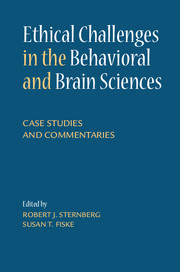Book contents
- Frontmatter
- Contents
- List of Contributors
- Preface
- Part I Academic Cheating
- Part II Academic Excuses and Fairness
- Part III Authorship and Credit
- Part IV Confidentiality’s Limits
- Part V Data Analysis, Reporting, and Sharing
- Part VI Designing Research
- Part VII Fabricating Data
- Part VIII Human Subjects
- 44 Ethical Considerations When Conducting Research on Children’s Eyewitness Abilities
- 45 Studying Harm-Doing without Doing Harm
- 46 Observational Research, Prediction, and Ethics
- 47 Should We Tell the Parents?
- 48 Ethics in Human Subject Research in Brazil
- 49 Honesty in Scientific Study
- 50 Ethically Questionable Research
- 51 Commentary to Part VIII
- Part IX Personnel Decisions
- Part X Reviewing and Editing
- Part XI Science for Hire and Conflict of Interest
- Epilogue Why Is Ethical Behavior Challenging?
- Index
- References
44 - Ethical Considerations When Conducting Research on Children’s Eyewitness Abilities
Published online by Cambridge University Press: 05 February 2015
- Frontmatter
- Contents
- List of Contributors
- Preface
- Part I Academic Cheating
- Part II Academic Excuses and Fairness
- Part III Authorship and Credit
- Part IV Confidentiality’s Limits
- Part V Data Analysis, Reporting, and Sharing
- Part VI Designing Research
- Part VII Fabricating Data
- Part VIII Human Subjects
- 44 Ethical Considerations When Conducting Research on Children’s Eyewitness Abilities
- 45 Studying Harm-Doing without Doing Harm
- 46 Observational Research, Prediction, and Ethics
- 47 Should We Tell the Parents?
- 48 Ethics in Human Subject Research in Brazil
- 49 Honesty in Scientific Study
- 50 Ethically Questionable Research
- 51 Commentary to Part VIII
- Part IX Personnel Decisions
- Part X Reviewing and Editing
- Part XI Science for Hire and Conflict of Interest
- Epilogue Why Is Ethical Behavior Challenging?
- Index
- References
Summary
During the past two decades, an impressive body of scientific research has emerged concerning children’s eyewitness capabilities, documenting not only how well children remember salient prior experiences and how susceptible they are to errors but also the types of interview tactics that are most – and least – likely to lead to complete and accurate reports from children. Across this field, however, a recurring challenge has been how best to balance the need for ecological validity and tight experimental rigor with the ethical obligation to protect the child and family participants (see Fisher et al., 2013, for a discussion of ethics in research with children).
An example from our work illustrates how we have sought to find this balance. In 2007, we (Quas, Davis, Goodman, & Myers) conducted a study comparing children’s true and intentionally false reports of body touch. Children took part in a laboratory play event with a male confederate. For one group of children, while playing, the confederate put a sticker on their neck, honked their nose, and picked them up around the waist to retrieve an item on a shelf. For a second group, he engaged in the same play activities but did not touch the children or pick them up. We thus created a salient event that included touching components and was amenable to scientific control, thereby allowing us to systematically test how well children could later recount what happened, which included answering questions about touching.
- Type
- Chapter
- Information
- Ethical Challenges in the Behavioral and Brain SciencesCase Studies and Commentaries, pp. 131 - 133Publisher: Cambridge University PressPrint publication year: 2015

